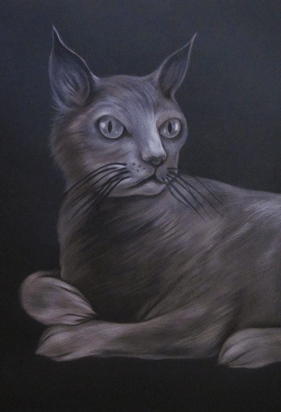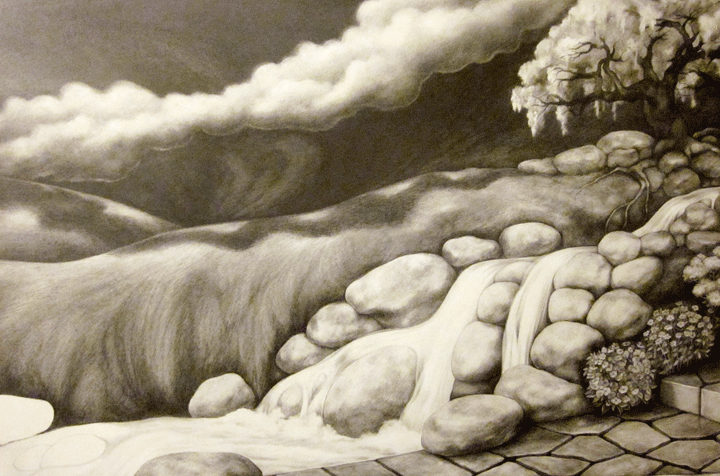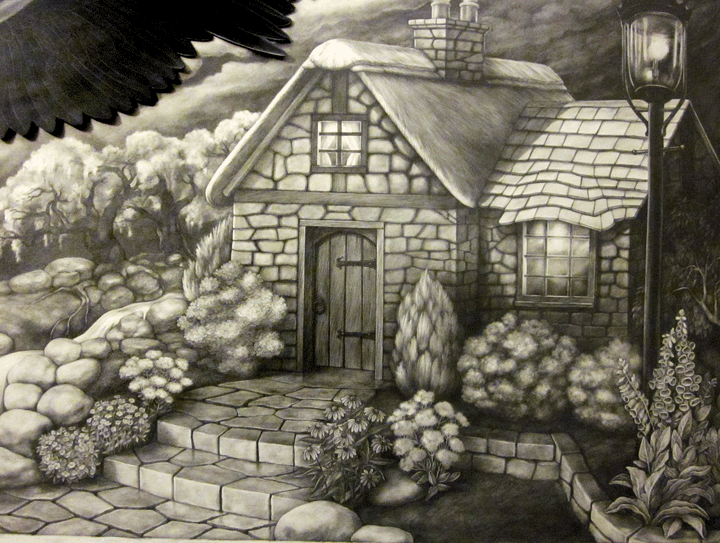I have a new appreciation for the paintings of Thomas Kinkade, and that is not a joke – I have been studying his work while recreating a Kinkade-style dreamy English cottage as part of my current large-scale drawing. I am not copying one of his paintings: although I am sure that legally I would be avoiding copyright infringement because the piece I am making would have used his work as a catalyst for only a section of a larger image. In other words, visually quoting the kitsch idea of peace and tranquility to heighten the confrontation of the War Paint portraits, but I prefer to not even skirt the copyright issue. My solution was to look at a lot of Kinkade’s paintings and use the clichéd sensibility of his work in order to recreate a syrupy and idyllic sense of the perfect home. And, more pragmatically, to create a house that would be a better fit into my own composition. Originally, I was visualizing a Maxfield Parrish-style home, but the more I looked at Parrish’s work, the more I began to think that it was too refined, too artistically sophisticated; I needed something slightly more sentimental, slightly more ironic. The home has to feel like a fairytale and have the undercurrent of unattainable serenity. In the end, there seems to be this amalgamation of Kinkade, Parrish, and a bit of Thomas Hart Benton (who I do not associate with cliché, but I do love his magnificent roiling landscapes and clouds).
The more I look at Kinkade’s work (I have to confess that I bought one of those calendars), the more I realize he is not a half-bad painter; he certainly can paint an English garden replete with foxgloves and stone garden walls. And, he is indeed the painter of light – lampposts, light coming through Tudor-style leaded-glass windows, clouds hovering over the soft glow of pink sunsets. He creates an implausibly unblemished, soft-edged beauty that looks great on nightlights, calendars, and machine-knitted throws; pleasant and unchallenging loveliness to decorate and accent the home – hence the reaction of distaste from a bevy of fine artists.
I do reference artists here and there, usually of the long-dead-European variety, to reference a concept or suggest a story, and occasionally I have copied to learn a technique. When I was in a freshman art history course, the graduate student teaching the class required the students to draw the Mona Lisa simply because most of the students could see and identify the painting, but very few of us had actually looked at the painting (I, for one, had never noticed her veil and the mountains in the background). The practice of observation and then rendering changes how one sees the work of other artists. It is rather amusing that in the process of actually looking at Kinkade’s work, I have overcome the impression of its tackiness and have studied his painting style; again, not at all bad, particularly since he has well-developed range of value (keeping the paintings from appearing too fluffy) and he has a knack for the textures of landscape, trees, shrubs, and flowers. Okay, so I do still long for meaning past the sugary and maudlin imagery – I have mentioned on more than one occasion that I would like to throw a slab of meat or a skeleton into one of his paintings just to give it a bit more edginess. But, I doubt that would please a public looking for imagery that brings comfort to the home or at the very least matches the sofa.
Truthfully, I am a little concerned that my attempt at recreating his sensibility will not have nearly the same syrupiness as an actual Kinkade, and thus it will lack the ironic edge – although I did draw a pretty fantastical cottage and garden, I am intrinsically unable to make something so soft and sentimental.
In this same drawing I am also recreating sections of Francisco Goya’s The Sleep of Reason, specifically the cats, the owls, and the bats. This is another artwork that, just like the Mona Lisa, I could recognize immediately, and I had perceived it as a whole without thinking about the details, but as I started to break the separate elements apart, I realized that the image is rendered in a manner very close to cartoon-style illustration with animals that are inaccurate and almost whimsical. In Goya’s work, however, the overarching despondency and emotion obscures the less realistic elements. Goya was a master of mood, his body of work encompassing both a removed, objective eye for the details of war, as well as the imperfections of royalty, and more theatrical displays of the wickedness and evil of man, not to mention witches and the spiritual realm, but for the most part the temperament displayed in his paintings is that of an artist who was a direct and honest conveyer of human nature. Although I have garnered a touch of appreciation for Kinkade’s painting style, it is Goya who I have grown to admire and love (even more than before) during this process – the inconsistencies, the flaws, and the raw emotion in his work is that of a true master.
It is the process of recreating the style/imagery of other artists that has been most surprisingly transformative for me in this drawing.
Back in the late nineties, when my husband was promoting an album by World Party, he was driving the musician Karl Wallinger (aka World Party) around to interviews, and Wallinger mentioned in a few of these that he had recorded a couple of Beatles songs note-for-note, just to break them down and to understand how the Beatles structured their songs: the self-assigned task of breaking apart the songs he so admired taught him how to better construct his own songs. This idea really stuck with me.
More than just creating another cover song, the process of actually deconstructing, synthesizing, and reconstructing another’s work is not simply a venture into regurgitating the past. Rather, it gives the artist the opportunity to internalize the canon, and to reflect over of the masters of his or her own media, discovering the imperfections and contradictions, and the enduring spirit of the artist’s work.
Not to mention the chance of finding a sliver of appreciation for an artist that previously had been purely the subject of jest.
Some work-in-progress pictures...bad photos, of course...it is too troublesome to drag the unweildy 48 x 72 inch drawing board into better light and, until sprayed with fixative, the pencil is too refective:
Oh yes, this could end up as one hot mess when it is done; there is a lot to resolve and hundreds of hours of drawing could be for naught. But, I am taking it in stride; for me, there is no growth in art – or enjoyment for that matter - without the risk of failure.
Oh, and my favorite cover song: that would probably be Elliot Smith's cover of the little George Harrison gem "Long, Long, Long".



